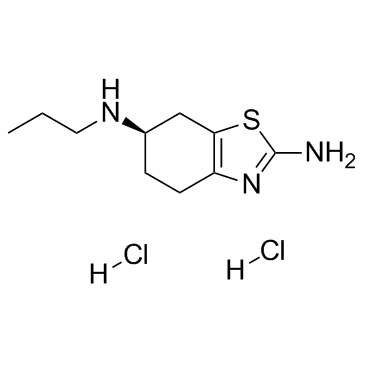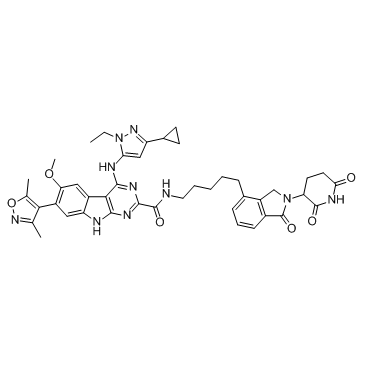 To enhance service speed and avoid tariff delays, we've opened a US warehouse. All US orders ship directly from our US facility.
To enhance service speed and avoid tariff delays, we've opened a US warehouse. All US orders ship directly from our US facility.
| Cat. No. | Product Name | Field of Application | Chemical Structure |
|---|---|---|---|
| DC22373 | Dexpramipexole dihydrochloride Featured |
Dexpramipexole 2Hcl(KNS-760704), also known as R-(+)-Pramipexole, is a neuroprotective agent and weak non-ergoline dopamine agonist. IC50 Value:Target: Dopamine ReceptorDexpramipexole has been found to have neuroprotective effects and is being investigated for treatment of amyotrophic lateral sclerosis (ALS). Dexpramipexole reduces mitochondrial reactive oxygen species (ROS) production, inhibits the activation of apoptotic pathways, and increase cell survival in response to a variety of neurotoxins and β-amyloid neurotoxicity. Compared to the S-(-) isomer, Dexpramipexole has much lower dopamine agonist activity.
More description
|

|
| DC11566 | BETd-260 Featured |
BETd-260 (ZBC260, BETd260) is a novel PROTAC BET degrader that tether HJB97 to a ligand for the E3 ubiquitin ligase VHL.
More description
|

|
| DC60322 | CYM 50358 hydrochloride Featured |

|
|
| DC60321 | WAY-352753 (GSK3-IN-1) Featured |
GSK3-IN-1 (compound 11) is a GSK-3 inhibitor with an IC50 value of 12 μM. GSK3-IN-1 can be used in the research of diabetes[1].
More description
|

|
| DC60320 | sigma-1 Receptor antagonist 2 Featured |
Sigma-1 receptor antagonist 2 is a potent and selective sigma 1 receptor (σ1 R) antagonist with Kis of 3.88 and 1288 nM for σ1 and σ2 receptor, respectively[1].
More description
|

|
| DC60319 | sigma-1 Receptor antagonist 1 Featured |
Sigma‑1 receptor antagonist 1 (compound 137) is a potent and selective sigma-1 receptor (σ1R) antagonist, with a high binding affinity to σ1R receptor (Ki = 1.06 nM). Sigma‑1 receptor antagonist 1 exhibits antineuropathic pain activity and acts as a promising agent for the treatment of neuropathic pain[1].
More description
|

|
| DC60317 | (E/Z)-ZINC09659342 Featured |
(E/Z)-ZINC09659342 is an inhibitor of Lbc-RhoA interaction[1].
More description
|

|
| DC82022 | Reserpine Featured |
Reserpine is an inhibitor of the vesicular monoamine transporter 2 (VMAT2).
More description
|

|
| DC47823 | Lepidiline A Featured |
Lepidiline A shows cytotoxic activity against HL-60 cells with an IC50 of 32.3 μM.
More description
|

|
| DC71242 | KCC009 Featured |
KCC009, a transglutaminase 2 (TG2) inhibitor, induces p53-independent radiosensitization.
More description
|

|
| DCAPI1097 | Allopurinol Sodium (Aloprim) Featured |
Allopurinol sodium is a potent xanthine oxidase inhibitor (IC50 values of 0.2 to 50 μM). Allopurinol sodium can be used for the research of hyperuricemia and gout. Antileishmanial effect[1][2].
More description
|

|
| DCAPI1349 | Simvastatin (Zocor) Featured |
Simvastatin (MK 733) is a competitive inhibitor of HMG-CoA reductase with a Ki of 0.2 nM.
More description
|

|
| DC72265 | GDC-2394 Featured |
GDC-2394 is an orally active and selective NLRP3 inhibitor, and also inhibits IL-1β with IC50s of 0.4 μM (human IL-1β) and 0.1 μM (mouse IL-1β). GDC-2394 inhibits NLRP3-induced caspase-1 activity without inhibiting NLRC4-dependent inflammasome activation.
More description
|

|
| DC72277 | Elvucitabine |
Elvucitabine is an L-nucleoside analogue. Elvucitabine is a potent nucleoside reverse transcriptase (RT) inhibitor. Elvucitabine can be used in research of viral infection.
More description
|

|
| DC72276 | AFM-30a hydrochloride |
AFM-30a hydrochloride is a potent protein arginine deiminase 2 (PAD2) inhibitor and has excellent PAD2-selectivity. AFM-30a hydrochloride binds to PAD2 with an EC50 value of 9.5 μM. AFM-30a hydrochloride also inhibits H3 citrullination with an EC50 value of 0.4 μM. AFM-30a hydrochloride can be used for the research of certain cancers and a variety of autoimmune diseases including rheumatoid arthritis (RA), multiple sclerosis, lupus, and ulcerative colitis.
More description
|

|
| DC72275 | Biotin-PEG3-C3-NH2 |
Biotin-PEG3-C3-NH2 is a PEG-based PROTAC linker, with NH2 functional group, that can be used in the synthesis of PROTACs.
More description
|

|
| DC72274 | 4-Azidobutylamine |
4-Azidobutylamine is a PROTAC linker, which refers to the alkyl chain composition. 4-Azidobutylamine can be used in the synthesis of a series of PROTACs. PROTACs contain two different ligands connected by a linker; one is a ligand for an E3 ubiquitin ligase and the other is for the target protein. PROTACs exploit the intracellular ubiquitin-proteasome system to selectively degrade target proteins.
More description
|

|
| DC72273 | SPAA-52 |
SPAA-52 is an orally active, competitive and reversible low-molecular-weight protein tyrosine phosphatase (LMW-PTP) inhibitor (IC50=4 nM, Ki=1.2 nM). SPAA-52 can be used in diabete research.
More description
|

|
| DC72272 | Safrazine |
Safrazine is an irreversible, non-specific and orally active monoamine oxidase (MAO) inhibitor. Safrazine can be used for the research of depression.
More description
|

|
| DC72271 | Indazole |
Indazole, also called isoindazole, a heterocyclic aromatic organic compound. Its derivatives display a broad variety of biological activities including anti-inflammatory, antibacterial, anti-HIV, antiarrhythmic, antifungal and antitumour properties. Indazole and its derivatives can be used for research of cancer, neurological disorders, cardiovascular diseases, gastrointestinal diseases.
More description
|

|
| DC72270 | Pivalylbenzhydrazine |
Pivalylbenzhydrazine (Pivhydrazine) is a potent monoamine oxidase (MAO) inhibitor. Pivalylbenzhydrazine decreases cartilage growth in normal rats. Pivalylbenzhydrazine can be used in research of depression.
More description
|

|
| DC72268 | Larsucosterol (trimethylamine) |
Larsucosterol (DUR-928) trimethylamine, a cholesterol metabolite, is a potent liver X receptor (LXR) antagonist. Larsucosterol trimethylamine as a potent endogenous regulator decreases lipogenesis. Larsucosterol trimethylamine inhibits the cholesterol biosynthesis via decreasing mRNA levels and inhibiting the activation of SREBP-1.
More description
|

|
| DC72267 | dBRD4-BD1 |
dBRD4-BD1 is a selective and durable BRD4 degrader with an DC50 value of 280 nM (Dmax=77%). dBRD4-BD1 upregulates BRD2/3 protein level and shows low cytotoxicity than iBRD4-BD1.
More description
|

|
| DC72266 | Romurtide |
Romurtide (Muroctasin), a synthetic muramyl dipeptide derivative, is a cytokines inducer. Romurtide can increase peripheral neutrophils and monocytes in vivo and enhance production of colony-stimulating factors (CSFs), IL-1 and IL-6 in vitro.
More description
|

|
| DC72264 | DMX-129 |
DMX-129 is an ΙΚΚε and TBK-1 inhibitor with IC50 values of <30 nM for both TBK1 and IKKε.
More description
|

|
| DC72263 | SKF107457 |
SKF107457 is an HIV-1 protease inhibitor that can be used in AIDS research.
More description
|

|
| DC72262 | DDO-2093 dihydrochloride |
DDO-2093 dihydrochloride is a potent MLL1-WDR5 protein-protein interaction inhibitor (IC50=8.6 nM; Kd=11.6 nM) with antitumor activity. DDO-2093 dihydrochloride selectively inhibits the catalytic activity of MLL complex.
More description
|

|
| DC72261 | A-446 |
A-446 is a potent glutaminase (GLS) inhibitor with an IC50 value of 31 nM.
More description
|

|
| DC72260 | TP-051 |
TP-051 is a potent FFAR1 agonist with an Ki value of 16 nM for human FFAR1. TP-051 can increase insulin secretion in rat insulinoma cells. TP-051 can be used to research type 2 diabetes.
More description
|

|
| DC72259 | BI-2081 |
BI-2081 is a GPR40 (FFAR1) partial agonist (EC50: 4 nM). BI-2081 induces glucose depending insulin secretion and reduces the plasma glucose concentration. BI-2081 can be used in the research of metabolic diseases, in particular diabetes type 2.
More description
|

|